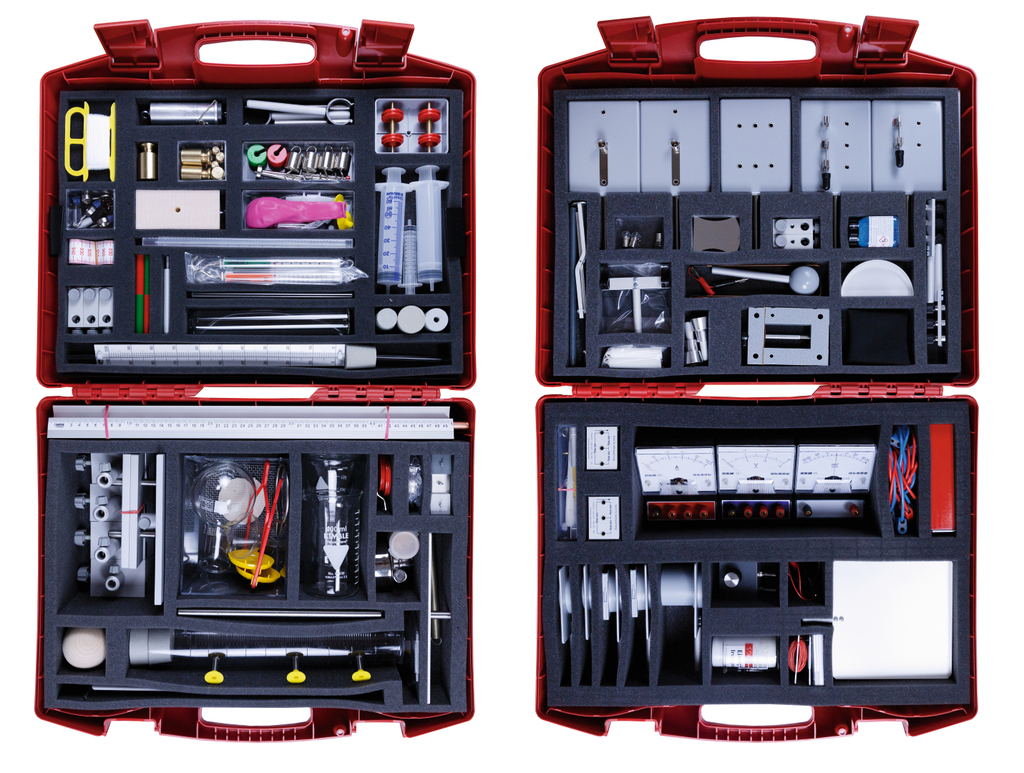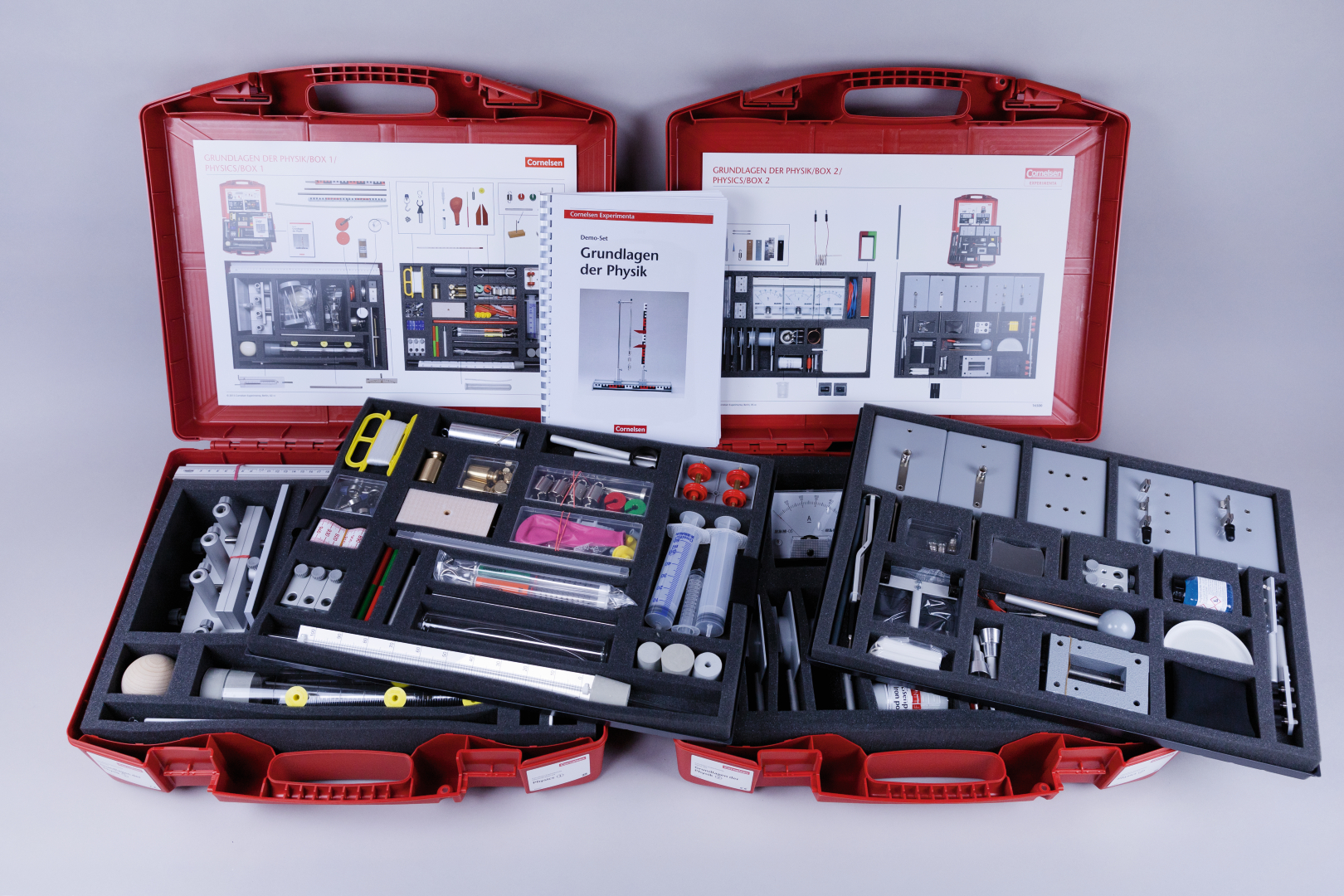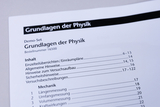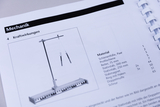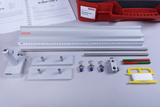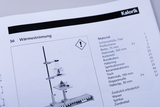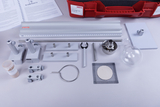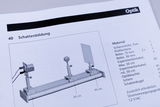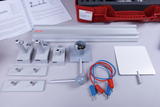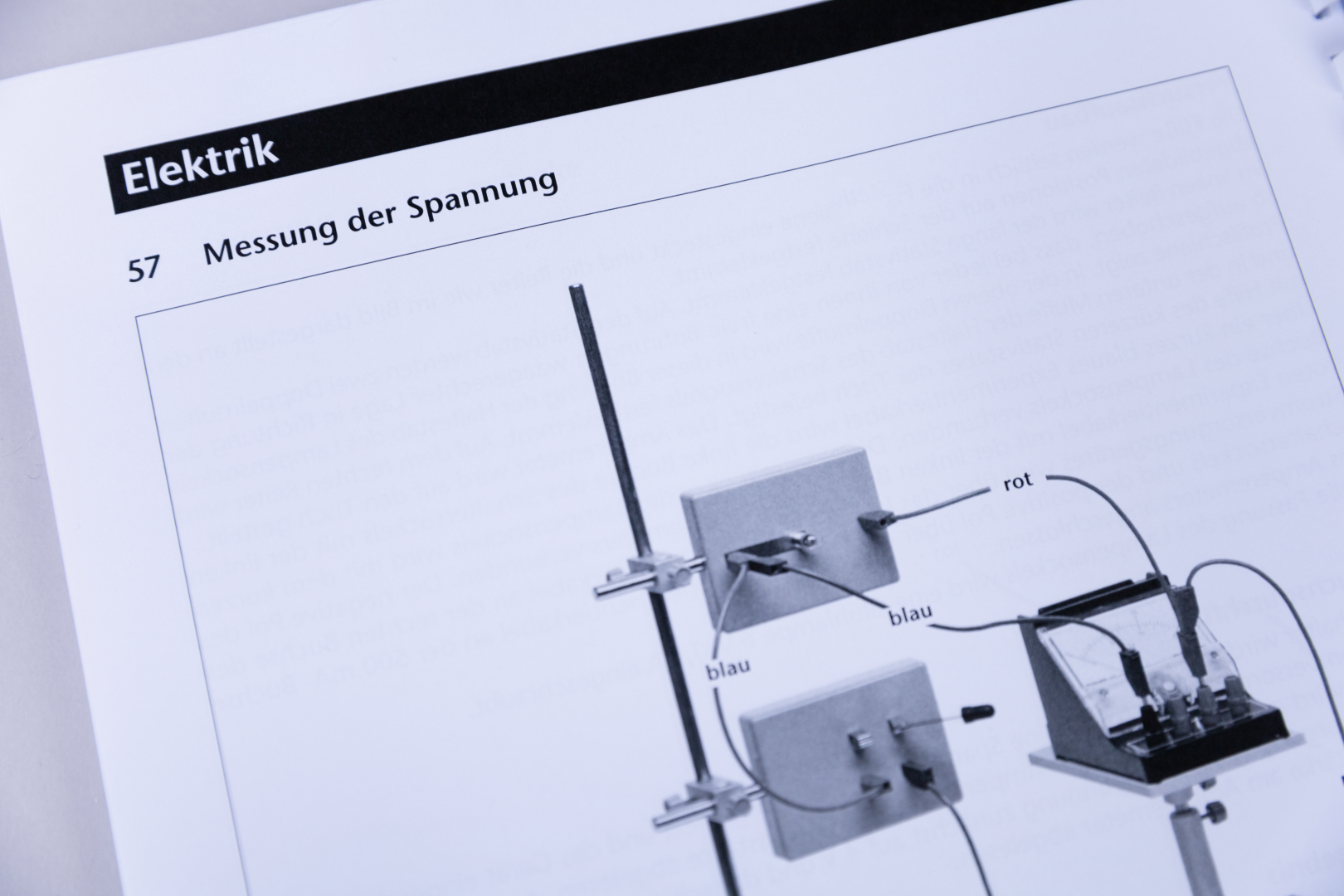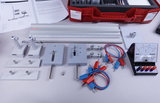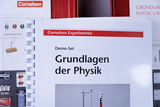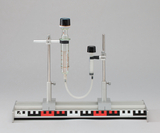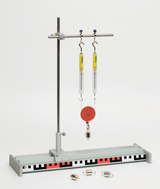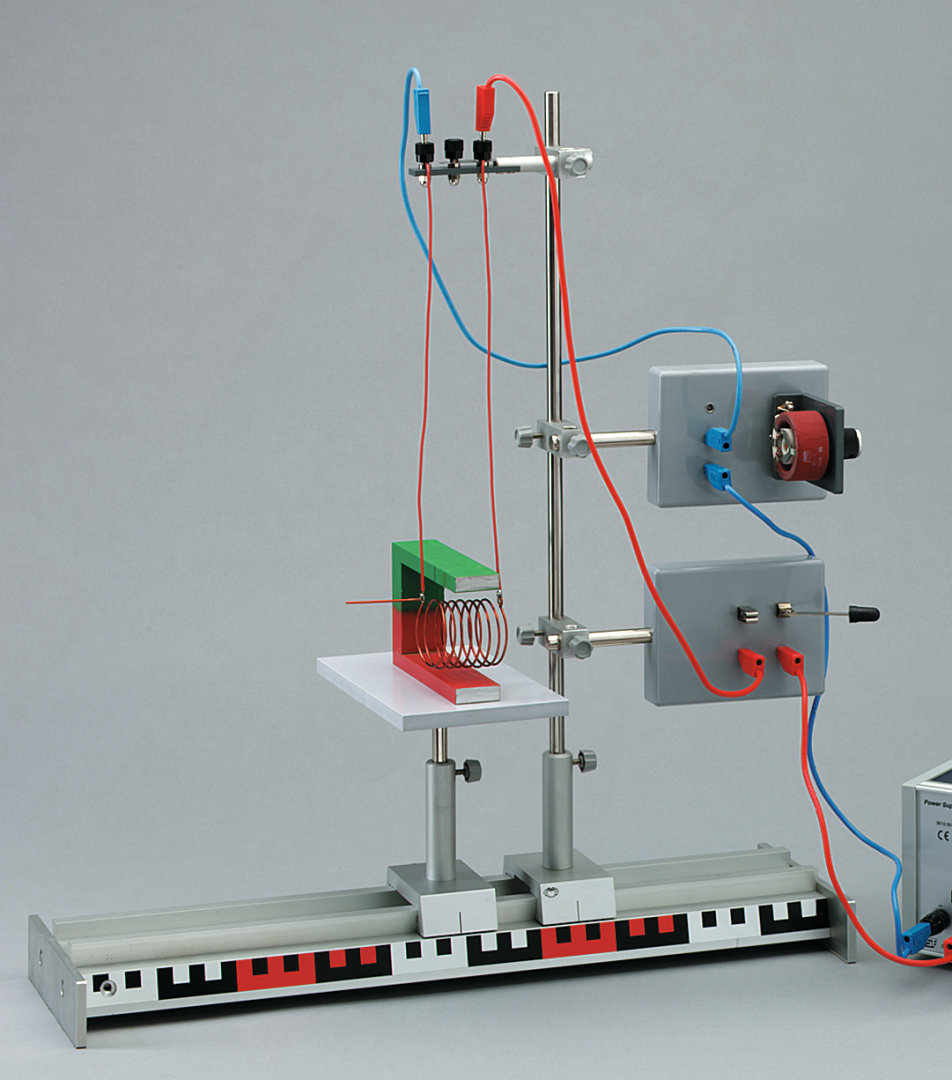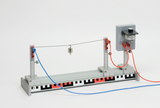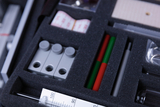Demonstration kit Physics
A very important basis for a profound and successful physics lesson is the demonstration of experiments. Even if your school is not equipped with a special science lab you need not refrain from this advantage.
The kit contains all the required materials, which are used to carry out the most important experiments which form the fundamentals of Physics. The stable and universal design of all parts allows a secure experimenting and guarantees a long durability.
No additional equipment is required for the execution of the experiments which can be carried out at any place and under nearly every climatic condition. Only for the demonstrations in the field of electricity a simple power supply is required in addition. The parts are compatible with the other parts of our program, so that the kit can always be supplemented.
Detailed instructions for 74 experiments:
- Mechanics (31 experiments)
- Heat (7 experiments)
- Optics (8 experiments)
- Electricity (28 experiments)
Technical specifications
Size of kit: 540x450x150 mm
Mass: 20 kg
We will shortly provide you with a description of the experiment at this point.
We will shortly provide you with a description of the experiment at this point.
We will shortly provide you with a description of the experiment at this point.
We will shortly provide you with a description of the experiment at this point.
We will shortly provide you with a description of the experiment at this point.
We will shortly provide you with a description of the experiment at this point.
We will shortly provide you with a description of the experiment at this point.
We will shortly provide you with a description of the experiment at this point.
We will shortly provide you with a description of the experiment at this point.
We will shortly provide you with a description of the experiment at this point.
We will shortly provide you with a description of the experiment at this point.
We will shortly provide you with a description of the experiment at this point.
We will shortly provide you with a description of the experiment at this point.
We will shortly provide you with a description of the experiment at this point.
We will shortly provide you with a description of the experiment at this point.
We will shortly provide you with a description of the experiment at this point.
We will shortly provide you with a description of the experiment at this point.
We will shortly provide you with a description of the experiment at this point.
We will shortly provide you with a description of the experiment at this point.
We will shortly provide you with a description of the experiment at this point.
We will shortly provide you with a description of the experiment at this point.
We will shortly provide you with a description of the experiment at this point.
We will shortly provide you with a description of the experiment at this point.
We will shortly provide you with a description of the experiment at this point.
We will shortly provide you with a description of the experiment at this point.
We will shortly provide you with a description of the experiment at this point.
We will shortly provide you with a description of the experiment at this point.
We will shortly provide you with a description of the experiment at this point.
We will shortly provide you with a description of the experiment at this point.
We will shortly provide you with a description of the experiment at this point.
We will shortly provide you with a description of the experiment at this point.
We will shortly provide you with a description of the experiment at this point.
We will shortly provide you with a description of the experiment at this point.
We will shortly provide you with a description of the experiment at this point.
We will shortly provide you with a description of the experiment at this point.
We will shortly provide you with a description of the experiment at this point.
We will shortly provide you with a description of the experiment at this point.
We will shortly provide you with a description of the experiment at this point.
We will shortly provide you with a description of the experiment at this point.
We will shortly provide you with a description of the experiment at this point.
We will shortly provide you with a description of the experiment at this point.
We will shortly provide you with a description of the experiment at this point.
We will shortly provide you with a description of the experiment at this point.
We will shortly provide you with a description of the experiment at this point.
We will shortly provide you with a description of the experiment at this point.
We will shortly provide you with a description of the experiment at this point.
We will shortly provide you with a description of the experiment at this point.
We will shortly provide you with a description of the experiment at this point.
We will shortly provide you with a description of the experiment at this point.
We will shortly provide you with a description of the experiment at this point.
We will shortly provide you with a description of the experiment at this point.
We will shortly provide you with a description of the experiment at this point.
We will shortly provide you with a description of the experiment at this point.
We will shortly provide you with a description of the experiment at this point.
We will shortly provide you with a description of the experiment at this point.
We will shortly provide you with a description of the experiment at this point.
We will shortly provide you with a description of the experiment at this point.
We will shortly provide you with a description of the experiment at this point.
We will shortly provide you with a description of the experiment at this point.
We will shortly provide you with a description of the experiment at this point.
We will shortly provide you with a description of the experiment at this point.
We will shortly provide you with a description of the experiment at this point.
We will shortly provide you with a description of the experiment at this point.
We will shortly provide you with a description of the experiment at this point.
We will shortly provide you with a description of the experiment at this point.
We will shortly provide you with a description of the experiment at this point.
We will shortly provide you with a description of the experiment at this point.
We will shortly provide you with a description of the experiment at this point.
We will shortly provide you with a description of the experiment at this point.
We will shortly provide you with a description of the experiment at this point.
We will shortly provide you with a description of the experiment at this point.
We will shortly provide you with a description of the experiment at this point.
We will shortly provide you with a description of the experiment at this point.
We will shortly provide you with a description of the experiment at this point.
- 1 × Syringe, plastic 10 ml
- 2 × Bosshead with slit for electrodes
- 2 × Dynamometer, 2 N
- 1 × Dynamometer, 5 N
- 1 × Dynamometer, 1 N
- 1 × Electrode, carbon with fixing sheet metal
- 1 × Loose pulley, 58 mm dia. with one hook
- 1 × Glass tube, straight, 200 mm
- 2 × Plastic box 60x50x30 mm
- 1 × Funnel for the suction flask 47563, 60 mm ø
- 1 × Wooden ball 60 mm Ø
- 1 × Tape measure 1 m, 10 pcs.
- 1 × Friction rubber, wool
- 2 × °Electrode, lead
- 1 × Slide with arrow motif
- 2 × Precision weight, 10g
- 1 × Rubber stopper 60/50 mm, for 44660
- 1 × Rubber stopper 34/28 mm
- 1 × Copper tube, 450x10 mm
- 1 × Slit double diaphragm, 1 slit/3 slits
- 1 × Optical model,half cylin-der, magnetic adhering
- 1 × Screen, translucent glass90 x 90 mm
- 1 × Cork powder ca. 10 g
- 1 × Table, small 180x110 mm
- 1 × Storing diagram,int.vers.(Phys.Demo-Set, kit 2)
- 1 × Storing diagram,int.vers.(Phys.Demo-Set, kit 1)
- 1 × Foam insert 2 for 16500, 515x370x90/10 mm (Box 2)
- 1 × Foam insert 1 for 16500, 505x355x30/5 mm (Box 2)
- 1 × Foam insert 2 for 16500, 515x370x100/5 mm (Box1)
- 1 × Foam insert 1 for 16500, 505x355x30/5 mm (Box 1)
- 2 × Syringe plastic, 50 ml
- 1 × Plug-in element base for three-pole elements
- 1 × Plastic box, clear, 60/40
- 1 × Copper wire with insulation (20 m)
- 1 × Pulley, unmounted, 58 mm dia.
- 1 × Thermometer, red spirit -10+110°C:1°C
- 1 × Tubing coupling
- 1 × Bulb, MES, 6,0 V/0,1 A set of 10 pcs.
- 1 × Stand rod, plastic 200x8 mm
- 1 ×
- 1 × Stand rod, 500x10 mmØ stainless steel
- 1 × Holding clip on rod, 15 mm Ø
- 1 × Magnetic needle 75 mm
- 3 ×
- 1 × Demo-ruler with block- scale 420 mm and rod
- 1 × Slotted mass, 50 g, red
- 1 × Plastic tubing 200 mm, 3x1 mm
- 1 × Moving coil model
- 1 × Light source w.l.pressurequartz-iodine bulb w.rod
- 1 × Drain vessel with 3 caps
- 1 × Pair of pointers, adjustable
- 1 × Pair of feet for rails
- 1 × Knife switch on base single pole, single throw
- 1 × U-and I-core with clamp screw, student type
- 1 × Capillary tubing with scale and rubber stopper
- 1 × Screen, white/black w.rod
- 1 × Bucket and cylinder
- 2 × Precision weight, 100g
- 1 × Precision weight, 200g
- 2 × Holding clip on rod, 30 mm Ø (rod: 100x10 mm)
- 3 × Rider with clamping tube 75 mm
- 1 × Screen and mirror supporton rod
- 1 × Voltmeter for students 3, 15, 30 V DC
- 1 × Rubber stopper 34/28 mm, 1 hole 8 mm
- 1 × Ammeter for students 50, 500 mA, 5 A
- 2 × Stand rod 250x10 mmØ stainless steel
- 1 × Rubber stopper 31/25 mm
- 1 × Retaining ring 75 mm Ø
- 1 × Lever with bearing and pointer
- 1 × Bodies for density determination, set of 3
- 1 × Conductor swing
- 1 × Friction block
- 1 × Knife switch on base single pole, double throw
- 2 × Candle holder on rod
- 3 × Plastic box, 140x50x25mm
- 1 × Zinc electrode
- 1 × Copper electrode
- 1 ×
- 1 × Copper sulphate, 50 g
- 2 × Plug lead, 50 cm, red
- 2 × Plug lead, 25 cm, blue
- 1 × Trough, plastic 173 x 132 x 70 mm
- 1 × Spring 150 mm / 10 N
- 2 × Insulating support with three clamps
- 1 ×
- 1 × String on spool
- 3 × Bosshead with slit
- 2 × Tray 510x360x20 mm
- 1 × Plastic box, smooth 64x64x15 mm
- 1 × Tubular clip, 5x4 mm
- 2 × Magnet rod, AlNiCo red/ green, 100 x 10 mmØ
- 1 × Electroscope with insulated rod and 4 mm plug
- 2 × Plastic case ca.540x450x150 mm
- 1 × Slotted mass, 50 g, green
- 1 × °Sifter with iron powder
- 1 × Needle support on rod
- 1 × Lens in frame, biconvex with rod, f = +100 mm
- 1 × All purpose rail, 500 mm with scale and bore
- 1 × Steel ball, set of 8 pcs.
- 1 × Precision weight, 50g
- 1 × Precision weight, 20g
- 1 × Precision weight, 5g
- 2 × Precision weight, 2g
- 1 × Precision weight, 1g
- 1 ×
- 1 × Galvanometer for students -35..0..+35 mV
- 1 × Condenser with diaphragm and slideholder
- 1 × Hole diaphragm, 2 mm dia.
- 1 × Shadow ball on rod
- 1 × Rider with clamping tube 30 mm
- 1 × Scale on board with rod
- 1 × Rail support rod for 47001/02
- 1 × Stand rod 100x10 mmØ stainless steel
- 1 × Diaphragm-and slideholder
- 1 × Surface tension ring
- 1 × Heat protection gauze
- 1 ×
- 1 × Carriage with rod and piece of mass
- 1 × U-tube manometer
- 1 × Metal axis 60 mm
- 1 × Silicone tubing, 7/1,5 mmper m
- 1 × Spirit burner, metal
- 1 × Lens in frame, biconcave with rod, f = -100 mm
- 1 × Bulb, MES, 1,5 V/0,15 A set of 10 pcs.
- 1 × Set of 100 rubber rings for soundplates
- 1 × Coil with 600 turns student type
- 1 × Coil with 1200 turns student type
- 2 × Connecting plug for 16500
- 2 × Plug lead, 25 cm, red
- 2 × Plug lead, 50 cm, blue
- 1 × Candles 100x13 mm, 20 pcs
- 1 × Heating wire , covered, 0,20 mm Ø (20 m)
- 5 ×
- 2 × Lampholder MES on base
- 5 ×
- 1 × Leaf spring 300x12 mm
- 1 ×
- 1 ×
- 1 ×
- 4 ×
- 1 ×
- 1 ×
- 1 ×
- 1 ×
- 1 ×
- 1 ×
- 3 ×
- 2 × Scale pan, yellow with red holder
- 1 × Rings with hook, set of 5
- 5 ×
